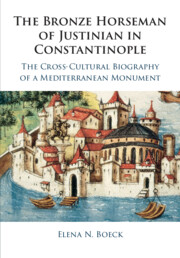 The Bronze Horseman of Justinian in Constantinople
The Bronze Horseman of Justinian in Constantinople Published online by Cambridge University Press: 08 April 2021
This chapter explains why Justinian’s equestrian monument survived the devastating pillaging of Constantinople in the aftermath of the Fourth Crusade. While numerous other statues perished or were shipped off as spolia from Latin-occupied Constantinople (1204–61), this imperial monument remained virtually unmolested and its stature and prominence further increased. Why was it that this great monument was singled out by the Latins for preservation? The short answer is simple – it became useful to Crusading ideology. Crusaders transformed the rider’s identity and remade him into the emperor Heraclius, who had become the great hero of the Crusading movement. By beholding in the bronze horseman their hallowed forefather, the occupiers were able to invest in the statue’s preservation. The process of reattribution unfolded between the eleventh and thirteenth centuries. Three texts highlight key moments in the monument’s reorientation: an eleventh-century Latin narrative dedicated to the mirabilia of Constantinople by the Anonymous of Tarragona, the twelfth-century romance Eracleof Gautier d’Arras, and the narrative of the Fourth Crusade penned by Robert de Clari.
To save this book to your Kindle, first ensure [email protected] is added to your Approved Personal Document E-mail List under your Personal Document Settings on the Manage Your Content and Devices page of your Amazon account. Then enter the ‘name’ part of your Kindle email address below. Find out more about saving to your Kindle.
Note you can select to save to either the @free.kindle.com or @kindle.com variations. ‘@free.kindle.com’ emails are free but can only be saved to your device when it is connected to wi-fi. ‘@kindle.com’ emails can be delivered even when you are not connected to wi-fi, but note that service fees apply.
Find out more about the Kindle Personal Document Service.
To save content items to your account, please confirm that you agree to abide by our usage policies. If this is the first time you use this feature, you will be asked to authorise Cambridge Core to connect with your account. Find out more about saving content to Dropbox.
To save content items to your account, please confirm that you agree to abide by our usage policies. If this is the first time you use this feature, you will be asked to authorise Cambridge Core to connect with your account. Find out more about saving content to Google Drive.